Message From the Executive Director
 
Dear VSI Members, Friends, and Donors,
Spring is said to be a time of new beginnings. But new beginnings can also lead to roads unknown. VSI may soon be heading down those roads.
We came to you in December explaining that VSI’s current business model is unstainable with the current level of funding.
It’s difficult to adequately express our level of gratitude to each and every donor,
and each and every donation received, both large and small.
Your response has been both encouraging and affirming – generating an increase in both donors and donation amounts, including a measureable number of long-time members/first time donors, as well as nearly doubling the number of recurring monthly donors which, like our Supporting Members, are the life-blood of the organization.
Though these stats are notable, the actual bottom-line dollar amount has not increased to the extent needed to impact operational services.
I have served this organization to the best of my ability for over 10 years. With each passing year has come an increase in demands, responsibilities, and expectations. Although funding continues to increase incrementally, it’s not kept pace at levels sufficient to meet the ever-increasing demands with desperately needed staffing assistance.
Did you know?
VSI’s quarterly e-newsletters are the only patient resource of its kind. Unquestionably one of the organization’s greatest educational resources, each edition brings the most current vitiligo information available to our entire worldwide membership.
We’ve been told that VSI’s member response to the newsletter research recruitment announcements has completely carried some of the most important vitiligo research in the world |
While providing this information is at the heart of our mission, it comes at a cost.
In addition to IT labor and expense, and newsletter software and hosting,
this newsletter alone took over 300 man-hours to research, write, and produce.
Many times I’m in the office in excess of 60 hours a week. The chronic, long-term stress has taken a significant, if not insurmountable, toll on my health. I’ve forfeited numerous family milestones and vacations. All the while, more and more requests for support and services go unanswered. Clearly this path is not sustainable, for me or the organization.
To maintain our mission and the current level of operation in 2020,
VSI must add a full-time staff person by the end of this year.
Depending on your funding response and outcome, we have three options:
Best-Case Scenario:
We raise adequate funding to maintain current programs and hire additional staff:
VSI will finally be able to grow and increase much-needed support and services.
Increased, but Inadequate Response:
Funding continues at an incremental increase, insufficient for growth:
Restructure the organizational mission, reducing current services and resources by 50%.
Worst-Case Scenario:
Funding level remains at, or close to, the same:
Adapt the organizational mission to reflect funding capacity,
setting patient support and education back in time by 10 years….
Begin an exit plan.
The choice is yours.
Please Give from the Heart
|
Sincerely,

Jackie Gardner
Executive Director
Childhood Vitiligo
Update on Management and Treatments
This first of a two part article explores the many complex facets and considerations of successful management of childhood vitiligo.
Regardless of your current age, if you developed vitiligo before the age of 18, or, if you are the parent or caregiver of a child with vitiligo, in addition to explaining the importance of this two-pronged interrelationship, this article will provide and explain the many elements involved with optimal childhood vitiligo management and therapy.
With an incidence of up to 2% of the world population, vitiligo is not a rare disease, and childhood-onset represents nearly half of all vitiligo cases. However, children are not just little people when it comes to managing vitiligo.
Managing Childhood Vitiligo
Childhood vitiligo has a variety of unique elements that can directly and indirectly impact not only the eventual success or failure of a treatment or therapy, but also the child’s self-esteem and sense of well-being, as well as having profound and life-long psychosocial and psychological repercussions.
 Unlike adult-onset vitiligo, an integral aspect of pediatric therapy is the psychological impact on the parents/caregivers who, according to research, often feel overwhelmed, experiencing guilt, frustration, and financial strain. They frequently feel significant emotional distress, as well as physical and mental fatigue. Unlike adult-onset vitiligo, an integral aspect of pediatric therapy is the psychological impact on the parents/caregivers who, according to research, often feel overwhelmed, experiencing guilt, frustration, and financial strain. They frequently feel significant emotional distress, as well as physical and mental fatigue.
Feelings of self-blame can lead to becoming overly focused on treatment and care, which can interrupt family plans and activities and affect relationships with other family members.
Mothers, frequently more involved with these plans and activities tend to experience higher levels of stress and negative feelings than fathers, which can impact housework, time spent on shopping and meal preparations, resulting in interference with social life/health, leading to a greater negative impact on over-all quality of life (QOL).
Another element of concern is the trickle-down impact
of parental anxiety on the well-being of the child.
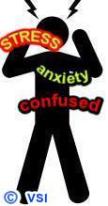 
A 2013 study noted the intense emotional and biological parent/child bond, and the degree of regulation and influence this relationship has on children’s behavior.
Study Objective:
“To evaluate the presence of anxiety and depression in caregivers of pediatric patients
with chronic skin disorders, exemplified by atopic dermatitis, psoriasis and vitiligo,
and
correlate them to the quality of life of the patients.”
Citing the emotional vulnerability of children between the ages of 5 – 16, surveys were conducted on 43 children with vitiligo in this age range and their parent/caregivers. The “Children's Dermatology Life Quality Index” was used to assess the children’s QOL on a range of topics, including symptoms, feelings, school, holidays, personal relationships, sleep, and treatment.
The level of anxiety in the parent/caregivers was measured using the Hamilton Anxiety Scale (HAS), and depression measured using the “Beck Depression Inventory (BDI).”
The results found measureable levels of anxiety in 42%, and depression in 26% of those responsible for patients with vitiligo. The analysis also revealed:
“a significant correlation between poor QOL in patients with vitiligo
and the presence of depression and anxiety in their caregivers.”
  Children are like sponges, soaking up and retaining environmental influences. Anxiety, fears, and negative feelings are contagious and easily transferred to children. Obsession and worry about a child’s health can convince the child that they, too, should be worried and upset. This unnecessary stress can lead to emotional problems, anxiety, loss of self-esteem, introversion, and social withdrawal. Children are like sponges, soaking up and retaining environmental influences. Anxiety, fears, and negative feelings are contagious and easily transferred to children. Obsession and worry about a child’s health can convince the child that they, too, should be worried and upset. This unnecessary stress can lead to emotional problems, anxiety, loss of self-esteem, introversion, and social withdrawal.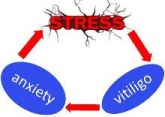
Research is clear on the topic of stress and vitiligo. Multiple studies have determined that the initial development, or subsequent flares of vitiligo, often follow an episode of emotional or psychological stress. This is most often observed with non-segmental vitiligo. This further demonstrates the importance of psychological and emotional support.
Click here to read more about stress, and take a test to find your level of stress
Emotional Support
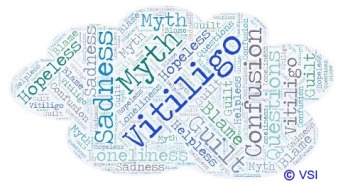
Support groups help build a supportive social network, providing unique emotional bonding and a sense of belonging in a group by sharing personal thoughts, feelings of guilt and frustration, concerns (including financial concerns over treatment costs), and experiences with others facing similar challenges, without fear of being judged. Friends and family can offer encouragement, but it’s never the same as talking with others who have experienced the same personal day-to-day struggles.
Support groups have also demonstrated improved QOL for siblings feeling left out due to an increased focus on the affected child. All who have attended support groups have reported decreased anxiety and feelings of helplessness and loneliness.
Education:
Overcome Fears and Confusion
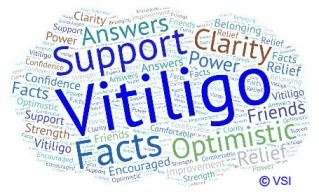
Numerous research studies have shown measurable improvement of vitiligo, as well as management skills, and over-all QOL for parents/caregivers who have access to accurate and reliable educational materials, and/or the opportunity to participate in disease-specific educational workshops and programs.
Many failed therapies are the result of fears (even phobias) attributable to a lack of accurate information, combined with a misunderstanding of treatment facts. This lack of knowledge can result in abandoning proven treatments in favor of alternative therapies, “internet cures,” and/or unnecessary and indiscriminate dietary restrictions, potentially leading to nutritional deficiencies.
Internet: Fact, Fiction, Opinion, and Spin
Hard copy resources once relied on for reliable information have long since been replaced by the internet, which is easily accessible and provides a wealth of information. However, this can be a double-edged sword. It’s important to remember that not all information is equal. Some sites make claims and provide sources, but are the sources valid? Valid sources can be checked for accuracy, and cross-checked in multiple locations, not just on the one website making the claim.
If there were a CURE for vitiligo, it wouldn’t be tucked away
on an obscure website whose sole purpose was to SELL a product.
“But wait,” you say, “look at all of those testimonials!”
  If the testimonials are all on the same website as the company selling the product, and are all positive, that’s a red flag. It doesn’t automatically mean the information is inaccurate – but it does warrant an independent cross-check on other unbiased websites. If the testimonials are all on the same website as the company selling the product, and are all positive, that’s a red flag. It doesn’t automatically mean the information is inaccurate – but it does warrant an independent cross-check on other unbiased websites.
Medically-approved treatments have years of verifiable research and publically provide the treatment statistics, results, side effects, and safety records on countless reputable, verifiable websites.
 The content of some web pages, such as social media pages and blogs, is primarily opinion. Opinions are based on personal beliefs which may, or may not be based on substantiated fact. One person’s experience is just that. Their interpretation of that experience is subjective to their personal background and knowledge, which may, or may not be based on verifiable facts. The content of some web pages, such as social media pages and blogs, is primarily opinion. Opinions are based on personal beliefs which may, or may not be based on substantiated fact. One person’s experience is just that. Their interpretation of that experience is subjective to their personal background and knowledge, which may, or may not be based on verifiable facts.
  One of the greatest misconceptions regarding vitiligo is that treatments don’t work. This is categorically untrue. Many times, VSI hears from patients who say they’ve tried everything and nothing worked. However, when asked, they admit that they didn’t use the treatment as prescribed, and quit before it had a chance to provide results. One of the greatest misconceptions regarding vitiligo is that treatments don’t work. This is categorically untrue. Many times, VSI hears from patients who say they’ve tried everything and nothing worked. However, when asked, they admit that they didn’t use the treatment as prescribed, and quit before it had a chance to provide results.
Urban legends on the topic of vitiligo span centuries. Don’t fall victim to the myths. The ever-increasing exposure to unsubstantiated information via the internet, social media, and blogs only serves to perpetuate misinformation and create more confusion and anxiety for those most vulnerable.
The bottom line:
Education truly is power. Arm yourself with facts. Investing your time pursuing accurate and verifiable, educational resources, is the first step in replacing apprehension with confidence and determination, and providing a strong foundation for both you and your child.
Successful treatment depends on far more than medication
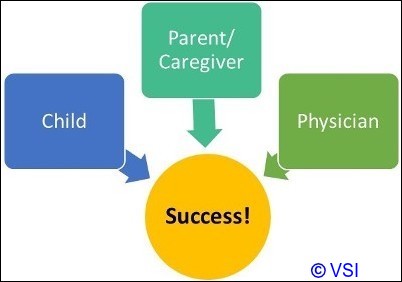
Optimal therapy for childhood vitiligo is not only multidimensional, but also requires a strong interdependent alliance between the parents/caregivers, the patient, and the physician. Each individual plays an equally important role in the treatment decision process, as well as its eventual outcome or failure.
The child depends on the parents to provide a supportive and stable environment. The parents depend on the physician to provide professional advice on the best treatment and therapy. The physician depends on the parents to provide a stable environment for the child and to administer the treatment as directed. The parents depend on the child to comply with the physician’s directions.
Which treatment is best for my child?
The physician must identify and weigh a variety of child-specific factors when deciding the best course of therapy.
Childhood Vitiligo Treatment Factors
Child’s age and developmental status
Child’s age at the time of disease onset
Type of vitiligo
Location and extent of involvement
Lesion age
Psychological impact
Potential associations with other autoimmune diseases |
The physician must also consider the child’s school schedule and after-school activities when developing the most effective, age appropriate plan of action.
One of the first considerations for treatment protocol of any patient is identifying the type of vitiligo, as each type is unique, not only in terms of prognosis, but manner of progression and response.
Primary Types of Vitiligo
Segmental Vitiligo (SV)
 
SV accounts for 10% to 15% of all types of vitiligo.
One-third of childhood vitiligo cases are SV.
Keeping in mind that when it comes to vitiligo there can be exceptions to every rule…
Typical SV Characteristics:
Begins at an early age
Typically affects only one side of the body, with a distinct midline demarcation; however, there have been cases of two or more affected areas on the same side, as well as, opposite sides of the body.
Spreads rapidly at onset, then stabilizes after a few months
Not generally associated with autoimmunity
The great majority will lose hair pigment in affected area.
Nonsegmental Vitiligo (NSV)
 
The most common type of vitiligo
Also known as generalized vitiligo
Accounts for nearly 80% of all vitiligo cases
Is an autoimmune (A/I) disease
Typical NSV Characteristics
Pigment loss on multiple areas of the body, sometimes in a symmetrical, or mirror like pattern.
Onset or flares may be preceded by period of emotional stress (exams, job loss, death in family, divorce etc.)
Can begin on any area of the body, but common areas of onset are the fingers, hands, and face.
Intense itching (at involved site) at onset, but prior to noticeable pigment loss, resolving after the depigmentation. This is caused by the A/I inflammatory process
Common on bony prominences and areas of the skin that rub together such as armpits and thighs
*Common, but underreported areas: inside mouth, soles of feet, and palms of hands
* A benefit of early discovery of these less visible/obvious sites is the ability to initiate treatment of the margins (of the lips, palms and soles) to prevent spreading to the more visible areas of the face, hands, and feet.
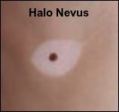 Frequently associated with thyroid disease. Frequently associated with thyroid disease.
Multiple halo nevi (moles surrounded by a white ring or halo) are another sign of autoimmunity. These moles are almost always non-cancerous.
NSV includes all types of vitiligo other than SV, such as the following:
Acrofacial: less common in children; generally affects the face, hands, feet, and orifices. In some cases, acrofacial evolves into generalized.
Focal: A small localized area of depigmentation without typical segmental distribution. (such as a single lesion crossing the midline of the body)
Universal/Universalis: Generalized vitiligo that has progressed to near complete depigmentation. Although some childhood cases have been reported, this is most often seen in adults.
Mixed Vitiligo (MV)
MV begins as SV, then later progresses into NSV, becoming MV. Once it progresses to generalized, it assumes those tendencies, including increased susceptibility to secondary A/I diseases. Identifying early susceptibility can mean earlier diagnosis, providing a better chance of early treatment.
Potential Signs or Symptoms of Increased Risk of MV (SV developing into NSV)
Family history of premature hair graying
Strong family history (immediate and extended) of autoimmunity
Halo nevi
Koebnerization (pigment loss at site of skin injury)
Itching (sign of inflammation)
NSV Subsets
Early-Onset (NSV) (age 12 years and under at onset)
Late-Onset (NSV) (over age 12 at onset)
Early-onset NSV has higher incidence of:
Halo nevi (higher number)
Premature graying of hair among immediate and extended family members.
(more than 50% white hair before the age of 40)
More genetic risk factors: higher genetic predisposition of developing secondary A/I diseases (for child as well as immediate and extended family)
Koebner phenomenon: pigment loss at the site of trauma, such as skinned knees, or areas of repeated friction, such as waistband
Atopy: allergic diseases such as allergic rhinitis, asthma and atopic dermatitis (eczema), as well as common inhaled and food allergens
Late-Onset NSV has higher incidence of:
Acrofacial pigment loss (face, hands, and feet)
Thyroid Disease
Regardless of age of onset, because NSV is an A/I disease, all of those with NSV have a genetic predisposition to developing other A/I conditions. This pre-disposition is higher among those who develop vitiligo before the age of 12 (and their immediate and extended family members). Research shows that 8.4% of parents of children with vitiligo have more than one A/I disease.
Widespread pigment loss, as well as the increasing number of years since disease onset, are the factors most associated with developing secondary A/I diseases. In other words, the longer a person has vitiligo (the older they get), the more likely the chance of developing other A/I diseases.
The most common secondary A/I disease is thyroid, and is more common in girls with vitiligo. Hypothyroidism (underactive thyroid) is six times more common than hyperthyroidism (overactive).
Research has found that nearly 25% of those with vitiligo have thyroid autoantibodies (autoantibodies target cells within your own body, and are markers of disease activity).
Click here for additional information on vitiligo and thyroid disease
Autoimmune Diseases
Genetically Associated with NSV:
Vitiligo
Autoimmune thyroid disease (particularly hypothyroidism)
Pernicious anemia
Addison’s disease
Systemic lupus erythematosus
Inflammatory bowel disease
Atopic dermatitis
Rheumatoid arthritis
Types 1 and 2 diabetes mellitus
Alopecia areata
Psoriasis
Celiac disease
Sarcoidosis
One final consideration when selecting the optimal therapy for childhood vitiligo is the child’s developmental status. There are 4 categories based on criteria such as psychological maturity, susceptibility to bullying, ability to comply/participate with the therapy, self-image development, and psychosocial issues.
Age and Developmental Categories
- Infant/toddler: 0--3 years
- School-aged children: 4–8 years
- Pre-teens: 9–12 years
- Adolescents: 13–17 years
|
The background we’ve provided here in part one lays the foundation for which types of treatments and therapies will be added to develop the best therapeutic course of management for your child.
Stay tuned for part two which will delve into the specifics of the most current treatment options available, and will address safety, efficacy, concerns, and other applicable criteria.

Back to Top
Calling all Medicare Vitiligo Patients!
  VSI regularly hears from patients from all over the United States who have been denied insurance coverage for their vitiligo treatment. VSI has been fighting this battle on a national level for several years. While we are definitely making progress, it’s been a slow road. VSI regularly hears from patients from all over the United States who have been denied insurance coverage for their vitiligo treatment. VSI has been fighting this battle on a national level for several years. While we are definitely making progress, it’s been a slow road.
Part of the problem is that currently there is no accepted standard for coverage of vitiligo treatments. Each company has their own policies and guidelines, many times based on outdated and incorrect information.
What most people may not realize is just how much private insurance coverage can be affected by Medicare policies. Over 55 million Americans are now covered by Medicare or Medicare Advantage, making it the nation’s largest health insurance program. Consequently, many, if not most, insurance providers establish their baseline standards and procedures to follow the Medicare model.
Medicare has agreed to meet with us – but requires that we bring Medicare letters of denial for a vitiligo treatment.
If you are reading this newsletter and you, or someone you know, was denied coverage for a vitiligo treatment by Medicare, please contact VSI immediately. You could help make a difference for future insurance coverage for ALL vitiligo patients! Click Here to Contact VSI
Back to Top


What's On Your Mind?
Q. Can vitiligo affect your sense of smell?
I have had vitiligo for more than 10 years. Within this past year I have developed a heightened sense of smell. Could this be related to vitiligo?
- While I am not aware of (and was unable to locate) any research on the topic of vitiligo and hyperosmia (heightened sense of smell), they do appear to have some commonality in causes and autoimmune associations.
  Research has shown that generalized vitiligo, an autoimmune condition, is genetically associated with a number of other autoimmune diseases, including Addison’s disease, an autoimmune disorder affecting the adrenal glands. Research has shown that generalized vitiligo, an autoimmune condition, is genetically associated with a number of other autoimmune diseases, including Addison’s disease, an autoimmune disorder affecting the adrenal glands.
Addison’s disease is also cited as a possible cause of hyperosmia. Hyperosmia can also be a symptom of adrenal deficiency, which can be a precursor to Addison’s disease.
Another potential cause of hyperosmia is a vitamin B12 deficiency. We also know from research that Vitamin B12 deficiency is more prevalent in those with vitiligo than in the normal population.
So while there does not appear to be a direct cause and effect relationship between vitiligo and hyperosmia, there appear to be circumstances by which both might occur in the same person.
Some Other Causes of Hyperosmia
Pregnancy: typically during the first trimester, associated with morning sickness
Migraine headaches: can cause a heightened sense of smell, and heightened sensitivity to smell can trigger migraines.
Lyme disease
Neurological disorders like multiple sclerosis, Alzheimer’s, and Parkinson’s disease
Any time you experience changes in your health,
it would be wise to consult your health provider.
Q. What’s the story with blueberries and vitiligo?
Some time ago I thought I read something about blueberries not being good for people with vitiligo, but I can’t remember any of the details. Can you explain?
- It’s interesting that you should ask that question at this time.
  Several years ago, a prominent dermatologist who spoke at a VSI conference mentioned that blueberries contain a natural substance (hydroquinone) that is used for skin lightening, and consequently should be consumed on a limited basis by those with vitiligo. Several years ago, a prominent dermatologist who spoke at a VSI conference mentioned that blueberries contain a natural substance (hydroquinone) that is used for skin lightening, and consequently should be consumed on a limited basis by those with vitiligo.
However, during a vitiligo forum at the recent American Academy of Dermatology Annual Meeting, in a discussion on the topic of foods that may be of benefit to those with vitiligo, this topic came up.
The lecturer noted that research indicates an imbalance between oxidants and antioxidants in those with vitiligo. Therefore, an increased intake of antioxidant rich foods might be of benefit. She stated that although there is limited data correlating antioxidant consumption with vitiligo health outcomes, these foods might be a positive adjunct therapy when combined with other prescribed vitiligo treatments.
Much to my surprise, the list of recommended, top-ranked antioxidant-rich foods included blueberries!

During the Q&A afterwards, I asked about the hydroquinone (HQ) level in blueberries, and if this was still a concern.
The panel noted that while blueberries do contain HQ, to date there have been no reported cases in literature of blueberries, or any other foods that contain HQ, inducing vitiligo. They also said that the antioxidant properties of blueberries would likely balance out any potential negative effect from HQ.
A 2008 Canadian report on environmental sources of HQ states that hydroquinone “has been detected in low levels in coffee, tea, red wine, beer, cola soft drinks, 2% milk, orange juice, corn, wheat and rice cereals, wheat germ, and various fruits, including pears, oranges, cantaloupes, cherries, asparagus, apples, blueberries and cranberries.”
A 2006 report co-authored by Pearl Grimes noted that while ingestion of foods high in HQ such as wheat cereal and wheat bread initially produce high levels of HQ in the plasma and urine, these levels peak around 2-3 hours afterwards, and return to baseline within 5 to 6 hours.
So it seems that blueberries can indeed be enjoyed in a balanced diet by those with vitiligo!

Medical News Updates
Highlights of recently-published medical
articles on vitiligo and its treatments
Milk Thistle and Vitiligo
  Silymarin, an extract from the silybum marianum (milk thistle) plant, comes in many therapeutic forms and has long been known for its anti-inflammatory, antioxidant, anti-viral, and immunomodulatory properties. The oral extract (silymarin) has been used for a multitude of ailments including diabetes, immune-mediated liver diseases, cancer, osteoporosis, heartburn, inflammatory bowel disease (ulcerative colitis), and enlarged prostate, as well as memory-related diseases such as Alzheimer's and Parkinson’s. Silymarin, an extract from the silybum marianum (milk thistle) plant, comes in many therapeutic forms and has long been known for its anti-inflammatory, antioxidant, anti-viral, and immunomodulatory properties. The oral extract (silymarin) has been used for a multitude of ailments including diabetes, immune-mediated liver diseases, cancer, osteoporosis, heartburn, inflammatory bowel disease (ulcerative colitis), and enlarged prostate, as well as memory-related diseases such as Alzheimer's and Parkinson’s.
A recent randomized, controlled clinical trial divided 34 vitiligo patients into two groups. The first group received NB-UVB phototherapy plus oral silymarin. The second group received NB-UVB phototherapy plus a placebo.
The results showed a greater repigmentation response in the group that also received the oral silymarin.
The authors concluded that silybum marianum is a good option for use with vitiligo. They also recommended further studies to confirm these findings.
Before you decide to try this out yourself, you need to be aware of potential side effects:
Diarrhea, nausea, bloating, gas, upset stomach
Severe allergic reaction for anyone allergic to ragweed
Because of its estrogenic properties, milk thistle should be avoided by women who are estrogen-dominant, as well as those with breast, uterine, or ovarian cancer.
Milk thistle also interacts with medications that are broken down by the liver, which can cause increased side effects from those drugs. It is advised that anyone considering the use of milk thistle, or any other supplement, first discuss this with your health care provider.

Back to Top
Research & Clinical Trials
Jak Inhibitor Study
New York City
Phase 2b Study to Evaluate the Efficacy and Safety of
Oral JAK Inhibitor with Active, Non-Segmental Vitiligo
Study Location:
Mount Sinai Union Square
10 Union Square East
New York, NY 10003
This study is seeking male and female patients ages 18-65 years, with a diagnosis of active, non-segmental vitiligo to participate in a study for a once daily by mouth medication.
Length of Study:
60 weeks maximum, including initial screening period and follow-up
Participation Involves:
Monthly visit to clinic
Blood and urine samples
Small samples of tissue (punch biopsy) from affected and unaffected areas
12-lead ECG to monitor heart rhythms
Audiograms to evaluate hearing
Inclusion Criteria:
Diagnosis of Active, non-segmental vitiligo with a degree of facial involvement
Women of childbearing potential must use one method of contraception
Sexually active men must use effective birth control if their partners are women of childbearing potential
Must agree to avoid prolonged exposure to sun and not use tanning booths, sun lamps or ultraviolet light sources
Exclusion Criteria:
History of human immunodeficiency virus (HIV) or positive HIV serology at screening
Infected with hepatitis B or hepatitis C viruses
Evidence of active, latent, or inadequately treated infection, with Mycobacterium tuberculosis (TB)
Recent or active suicidal ideation or behavior
Scheduled surgery during the study period
Pregnant or breastfeeding
To participate, or for more information,
Contact: Stephanie Tadayon
212-844-8625 or email [email protected] |
Online Depigmentation Survey
Calling all Depigmentation Patients!

VSI is assisting Pooja Reddy, a 4th year medical student from the Baylor College of Medicine, and Ammar Ahmed, MD, Dell Medical School, University of Texas at Austin, who are seeking feedback from those who are either currently in the process of, or those who have completed, the depigmentation process.
VSI is acutely aware of the difficulties many of our members have experienced when seeking a physician to prescribe depigmentation therapy.
We need you to help physicians better understand the impact
of this therapy and to provide first-hand insight into the patient perspective!
Participation involves:
Completing a brief online survey
Qualifications:
Respondents must have either:
♦ Completed the depigmentation therapy
OR
♦ Currently undergoing depigmentation therapy
If you qualify and would be willing to complete a brief survey, click here. |
Research Study in New York City
Recruiting Individuals
With & Without Vitiligo
Researchers in New York are seeking volunteers who have vitiligo, as well as those who do not have vitiligo. If you have vitiligo and would like to participate, bring a friend or family member who does not have vitiligo to participate as well!
Study Requirements:
Volunteers must reside in the NYC area
Volunteers must come to two (2) study visits at the clinic.
This is not a treatment study.
Researchers will be comparing pigment cells from those with vitiligo to those without vitiligo, to identify differences that may contribute to the progression of vitiligo, which may help to develop improved vitiligo treatments.
Study visits will take place at:
The Dermatology Clinical Studies Unit
NYULMC Ambulatory Care Center
240 East 38th Street, 11th Floor
New York, NY 10016
For more information, please contact:
Susan Cataldo, Research Coordinator:
212-263-5244 or email: [email protected] |
Earn Funding for VSI with Amazon and eBay
Online Shopping Can Benefit VSI!
|
Amazon Shopping for VSI
With thousands of items in addition to books, Amazon.com is a one stop-shopping center! Simply shop through the above link (bookmark it for easy reference) and VSI will earn fees, based on a percentage of the sale. The more items purchased by members, the higher the percentage!
Tobi Cares Donation Program
Tobi is an online women's clothing design label that brings LA style from its design studio
direct to its online clothing store at tobi.com. Go to Tobi Cares and sign up for VSI to receive 1% of your purchase amount.
iGIVE SHOPPING
iGive.com offers access to free shipping deals and exclusive coupons, on top of the great deals you'll find every day through its network of 1,000+ stores, including Pottery Barn, REI, Staples, Petco, Expedia, Best Buy, QVC and many more. Best of all, up to 26% of your purchase at each store is donated to VSI at no cost to you! Let friends and family know so they can support VSI, too. Click register for iGive to get started today, and download the iGive button to automatically benefit VSI whenever you go to an included store.
GOODSEARCH SHOPPING AND DINING!
GoodSearch and Goodshop, like iGive, offers coupons, discounts, and donations to VSI through its network of over 5,000 stores. Just click the link above to get the savings started and the donations flowing!
* Vitiligo Support International Inc. (VSI) is a participant in the Amazon Services LLC Associates Program, an affiliate advertising program designed to provide a means for sites to earn advertising fees by advertising and linking to Amazon.com. |
Support VSI Through Ebay
Support VSI with eBay!
Do you sell items on eBay, or want to hold an online garage sale? If so, consider donating a percentage of your proceeds to VSI through eBay’s Giving Works program! It’s easy – when you list an item through a Giving Works listing, choose to send 10-100% of the final sale price to VSI. Your listing will have a special placement and designation. You’ll receive a proportional fee credit from eBay, and will also receive a tax donation receipt when the donation is deducted from your funds received. It’s a great opportunity to make some money for yourself and for VSI, so clean out those closets and garages and get selling!
To Learn More About VSI's Giving Works: Click here |
|




 Unlike adult-onset vitiligo, an integral aspect of pediatric therapy is the psychological impact on the parents/caregivers who, according to research, often feel overwhelmed, experiencing guilt, frustration, and financial strain. They frequently feel significant emotional distress, as well as physical and mental fatigue.
Unlike adult-onset vitiligo, an integral aspect of pediatric therapy is the psychological impact on the parents/caregivers who, according to research, often feel overwhelmed, experiencing guilt, frustration, and financial strain. They frequently feel significant emotional distress, as well as physical and mental fatigue. 





 The content of some web pages, such as social media pages and blogs, is primarily opinion. Opinions are based on personal beliefs which may, or may not be based on substantiated fact. One person’s experience is just that. Their interpretation of that experience is subjective to their personal background and knowledge, which may, or may not be based on verifiable facts.
The content of some web pages, such as social media pages and blogs, is primarily opinion. Opinions are based on personal beliefs which may, or may not be based on substantiated fact. One person’s experience is just that. Their interpretation of that experience is subjective to their personal background and knowledge, which may, or may not be based on verifiable facts.



 Frequently associated with thyroid disease.
Frequently associated with thyroid disease.




